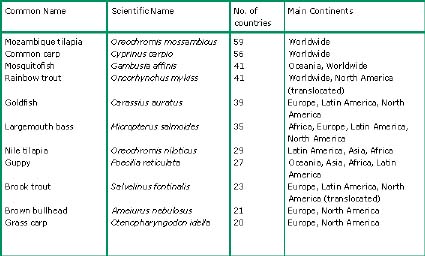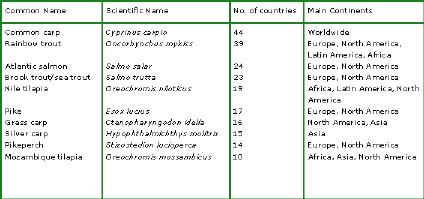Proceedings of the International Conference on Restoration of lake
trout in the Laurentian Great Lakes. vol.21, no. Suppl. 1, p. 30-53.
Fraser, J.M 1989. Establishment of reproducing populations of brook
trout after stocking of interstrain hybrids in Precambrian Shield lakes. N. Am. J.
Fish. Manage. vol. 9, no. 3, p. 352-363.
Gurgel, J.J.S. and Fernando, C.H. 1994. Fisheries in semi-arid
Northeast Brazil with special reference to the role of tilapias. Int. Revue Ges.
Hydrobiol. 79: 77-94.
Hale, M.M., Crumpton, J.E. and Schuler, R.J. 1995. From sportfishing
bust to commercial fishing boon: A history of the blue tilapia in Florida. In: Schramm,
H.L., Jr. Piper, R.G. (eds.). Uses and effects of cultured fishes in aquatic ecosystems.
Bethesda, Md USA American Fisheries Society. vol. 15, p. 425-430.
Haynes, G.T., Dunford, W.E. and Vascotto, G.L. 1982. Changes in
abundance and growth characteristics of white perch from the mouth of the Bay of Quinte. J.
Great Lakes Res. vol. 8, no. 4, p. 614-618.
Jones, M.L. and Stanfield, L.W. 1993. Effects of exotic juvenile
salmonids on growth and survival of juvenile Atlantic salmon (Salmo salar ) in a Lake
Ontario tributary. In: Gibson, R.J. and Cutting, R.E. (eds.). Production of juvenile
Atlantic salmon, Salmo salar , in natural waters. National Research Counc. of
Canada, Ottawa, Ont. Canada no. 118, p. 71-79.
Juarez-Palacios, J.R. and Olmos-Tomassini, M.E. 1991. Tilapia in
capture and culture-enhanced fisheries in Latin America. In: Balayut, E.A. (ed.). Indo
Pacific Fishery Commission, country reports presented at the fifth session of the Indo
Pacific Fishery Commission Working Party of Experts on Inland Fisheries, Bogor, Indonesia,
24-29 June 1991 and papers contributed to the Workshop on Tilapia in Capture and Culture
Enhanced Fisheries in the Indo Pacific Fishery Commission Countries, Bogor, Indonesia,
27-29 June 1991. FAO Fisheries Report. No. 458, Suppl. Rome, FAO. p.244-273.
Kaalaas, S. and Johansen, R. 1995. The common carp (Cyprinus carpio
L.) in Norway. Fauna Norv., Ser. A vol. 16, no. 1, p. 19-28.
Lee, D.P. 1995. Contribution of non native fish to California’s
inland recreational fishery. Uses and effects of cultured fishes in aquatic ecosystems.
Schramm, H.L., Jr. and Piper, R.G. (eds.). Bethesda, Md USA American Fisheries Society.
vol. 15, p. 16-20.
Lévêque, C. 1998. Fish species introductions in African fresh
waters. In: Cowx, I.G (ed.). Stocking and introduction of fish. Fishing News Books,
Blackwell Science, Oxford, p.234-257.
Machino, Y. 1995. The status of Salvelinus in France. In: Klemetsen,
A., Jonsson, B. and Elliott, J.M. (eds.) Proceedings of the Third International Charr
Symposium June 13-18 1994, Trondheim, Norway. vol. 71, p. 352-358. |
Marshall, B.E. 1991. The impact of the introduced sardine Limnothrissa
miodon on the ecology of Lake Kariba. Biological Conservation. 55: 151-165.
Moreau, J. 1987. Inland fisheries in Madagascar. In: Petr, T. (ed.).
Reports and papers presented at the Indo-Pacific Fishery Commission Expert Consultation on
inland fisheries of the larger Indo-Pacific islands. Bangkok, Thailand, 4-9 August. FAO.
Fish. Rep., 371, Suppl., 258 pp.
Mutenia, A. and Salonen, E. 1992. The vendace (Coregonus albula L.),
a new species in the fish community and fisheries of Lake Inari. In: Todd, T.N. and
Luczynski, M. (eds.). Biology and management of coregonid fishes 1990. Vol. 39, no. 3-4,
p. 797-805.
Petr, T. 1998. Review of the administration and of the benefits from
fishery enhancements in Australia. In: Petr, T. (ed.) Inland fishery enhancements.
Papers presented at the FAO/DFID Expert Consultation on Inland Fishery Enhancements.
Dhaka, Bangladesh, 7 11 April 1997. FAO Fisheries Technical Paper. No. 374. Rome, FAO. p.
65-78.
Rand, P.S., Hall, C.A.S., McDowell, W.H., Ringler, N.H. and Kennen,
J.G. 1992. Factors limiting primary productivity in Lake Ontario tributaries receiving
salmon migrations. Can. J. Fish. Aquat. Sci. vol. 49, no. 11, p. 2377-2385.
Shafland, P.L. 1995 Introduction and establishment of a successful
butterfly peacock fishery in Southeast Florida canals. In: Schramm, H.L., Jr. and Piper,
R.G. (eds.). Uses and effects of cultured fishes in aquatic ecosystems. Bethesda, Md
USA American Fisheries Society. vol. 15, p. 443-451.
Shirobokov, I.I. 1993. On the adventitious introduction of the trout
Oncorhynchus mykiss into the Irkutsk Reservoir. Vopr. Ikhtiol. vol. 33, no. 6, p.
841-843.
Soederbaeck, B. 1995. Replacement of the native crayfish Astacus
astacus by the introduced species Pacifastacus leniusculus in a Swedish lake: Possible
causes and mechanisms. Freshwat. Biol. vol. 33, no. 2, p. 291-304.
Spliethoff, P.C., Frank, V.G. and de Iongh, H.H. 1983. Success of
the introduction of the fresh water clupeid Limnothrissa miodon (Boulenger) in Lake
Kivu. Fisheries Management. Vol. 14, no. 1, p. 17-31.
Sugunan, V.V. 1995. Reservoir fisheries of India. FAO Fisheries
Technical Paper. No. 345. FAO, Rome.
423 pp.
Sugunan V.V. 1997. Fisheries management of small water bodies in
seven countries in Africa, Asia and Latin America. FAO Fisheries Circular. No. 933.
Rome, FAO, 149 pp.
Tsvetnenko, Yu.B. 1993. The effectiveness and genetic consequences
of the introduction of the stellate sturgeon, Acipenser stellatus, into the Azov Basin
from the Caspian Sea. J. Ichthyol.Vopr. Ikhtiol. vol. 33, no. 9, pp. 1-10, vol. 33,
no. 3, p. 382-387. |






